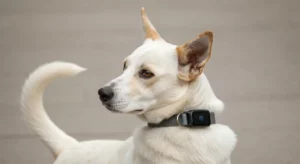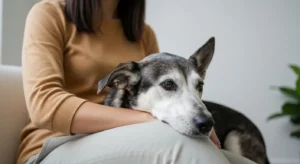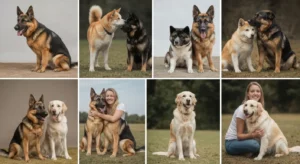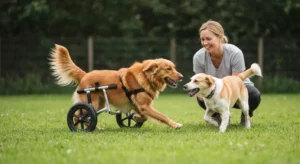I still see the ghost of him sometimes. A flash of gold, a blur of motion, launching himself into the back of the SUV, tail a furious metronome of joy. For twelve years, my Golden Retriever, Murphy, was a force of nature. He was my hiking partner, my co-pilot on road trips, and the furry, four-legged reason I got out of bed for a run on days I wanted to do anything but. His youth felt infinite. And then, one Tuesday afternoon, it wasn’t.
It wasn’t a dramatic event. There was no sudden collapse or frightening diagnosis. It was just… the couch. The same worn, leather couch he’d claimed as his throne since he was a lanky, clumsy puppy. He walked up to it, placed his front paws on the cushion as he always did, and prepared to hoist himself up. But he couldn’t. He tried again, a little huff of effort escaping his snout. His back legs trembled, and then he just… gave up. He slumped back to the floor, let out a long, weary sigh, and laid his head on his paws, staring at the spot he could no longer reach.
My heart cracked. In that single, quiet moment of defeat, the truth I’d been subconsciously avoiding hit me like a physical blow. My dog was old. And I had absolutely no idea what to do next. That was the beginning of my journey into understanding what it truly means to be raising a senior pet. It’s a path of profound love, heartbreaking adjustments, and a depth of connection I never knew was possible.
The First Hard Conversation: Acknowledging the Change
For a few weeks, I lived in a state of denial. I’d tell myself he was just tired, or that the floor was slippery. I’d lift his 80-pound body onto the couch myself, grunting with the effort, pretending it was a fun new game. But the signs kept piling up. He was slower to greet me at the door. Our three-mile walks became one-mile ambles. The tennis ball, once his obsession, now lay untouched in the grass. He wasn’t just slowing down; his entire world was shrinking, and my denial was only isolating him further.
The turning point was a visit to our long-time veterinarian, Dr. Anya Sharma. I went in for his annual checkup, armed with a list of “minor” concerns. I watched as she expertly ran her hands along his spine and legs, her brow furrowed in concentration. She had me walk him down the hallway, observing his gait with a keen eye.
“He has classic signs of osteoarthritis, especially in his hips and elbows,” she said gently, but without sugarcoating it. “It’s very common in large breeds his age. The pain is likely why he’s hesitant to jump and less interested in long walks. It’s not that he doesn’t want to, it’s that he can’t without discomfort.”
Hearing a medical term for his slowdown was both a relief and a sorrow. It wasn’t just in my head. This was real. Dr. Sharma explained that our goal was no longer about pushing limits, but about managing comfort and maximizing his quality of life. This shift in perspective was the single most important step in my journey of raising a senior pet.
Expert Tip: Proactive Vet Care is Non-Negotiable.
Don’t wait for a crisis. Once your pet enters their senior years (around 7-8 for larger breeds, 9-10 for smaller ones), switch to bi-annual vet checkups. These visits are crucial for catching age-related issues like arthritis, kidney disease, dental problems, and cognitive changes early. Be radically honest with your vet about every little change you observe, no matter how small. A detailed history is their most powerful diagnostic tool.
Phase Two: Rebuilding Our Home and Habits
Armed with a diagnosis and a new mission, I came home and saw my house through Murphy’s eyes for the first time. The gleaming hardwood floors I loved were a treacherous ice rink for his unstable legs. The stairs to the bedroom were a mountain he was forced to climb every night. The world I had built for us was no longer built for him.
My first project was traction. I went online and ordered a small army of non-slip rug runners and placed them in every key pathway: from his bed to his water bowl, from the living room to the back door. The change was immediate. He walked with more confidence, his feet gripping the soft surface instead of splaying out on the slick wood.
Next was the furniture problem. Lifting him was not a sustainable solution for my back or his dignity. After some research, I invested in a low-incline, wide-based pet ramp for the couch. The first few days, he eyed it with deep suspicion, refusing to go near it. I spent an afternoon luring him up with a trail of his favorite treats, praising him excessively for every step. By the end of the week, he was trotting up and down it like a pro, reclaiming his spot on the couch with a proud, happy snort. We got a second one for the car, and just like that, road trips were back on the table.
We also had to completely rethink exercise. Our long, strenuous hikes were over. It was a hard pill to swallow; those hikes were a core part of our bond. But I learned to find joy in a new kind of outing. We started going on “sniffaris”—slow, meandering walks where the goal wasn’t distance, but sensory exploration. I let him lead the way, sniffing every bush and blade of grass for as long as he wanted. These calm, twenty-minute strolls tired him out just as much as our old runs, but without the painful impact on his joints.
What I Learned: Adapt Your Environment for Safety and Comfort.
Making your home senior-friendly is one of the kindest things you can do. Consider these changes:
- Add Traction: Use rug runners, non-slip mats, or even adhesive paw grips to prevent dangerous slips and falls on hard flooring.
- Invest in Ramps: Ramps for furniture and cars preserve your pet’s independence and protect their joints (and your back!).
- Upgrade Their Bed: An orthopedic, memory-foam bed provides crucial support for arthritic joints and can dramatically improve their sleep quality.
- Raise Food and Water Bowls: Elevated bowls can reduce strain on the neck and back, making mealtimes more comfortable.
Fueling the Golden Years: The Power of Nutrition and Supplements
Dr. Sharma had also been clear that what Murphy ate was now more important than ever. We transitioned him from his adult formula to a high-quality senior dog food. She explained that senior diets are typically lower in calories to prevent weight gain (extra weight is hell on old joints) and often have added ingredients to support aging bodies.
But the real game-changer was a targeted supplement regimen. On my vet’s recommendation, I started a three-pronged attack on his arthritis:
- Glucosamine and Chondroitin: I started thinking of these as lubricants for his joints. They are natural compounds that help support cartilage and joint fluid.
- Omega-3 Fatty Acids (Fish Oil): This was my favorite. Not only does it support joint health with its anti-inflammatory properties, but it’s also fantastic for their coat and cognitive function.
- A prescription anti-inflammatory (NSAID): This was the heavy lifter for pain management. Dr. Sharma was clear that we’d use the lowest effective dose and monitor his liver and kidney function with regular blood work.
It wasn’t an overnight miracle. For the first month, I wasn’t sure if any of it was working. But slowly, subtly, the old Murphy began to reappear in flickers. One morning, he met me at the door with a toy in his mouth for the first time in a year. Another day, he broke into a brief, clumsy trot on our walk. The wince he used to have when getting up from his bed vanished. He was still an old dog, but he was a comfortable old dog. The pain was no longer the main character in his story.
Expert Tip: Consult Your Vet About Senior Nutrition and Supplements.
Don’t just grab a bottle off the pet store shelf. Your vet is your best resource for creating a nutritional plan. Discuss switching to a senior-specific food formula and ask about targeted supplements. For joint health, a combination of glucosamine, chondroitin, and omega-3s is a well-regarded starting point. For more advanced pain, prescription medications can be life-changing, but they require careful veterinary supervision.
Beyond the Body: Tending to an Aging Mind
Just as we found our rhythm with Murphy’s physical needs, a new, more unsettling challenge emerged. I started noticing moments of confusion. Sometimes I’d find him standing in a corner, just staring at the wall as if he’d forgotten how he got there. He occasionally started barking at nothing, or seemed not to recognize me for a fleeting second when I came into a room.
This was, by far, the hardest part of raising a senior pet. Arthritis I could understand. This felt different. It felt like I was losing him. Another call to Dr. Sharma introduced me to a new term: Canine Cognitive Dysfunction (CCD), the doggy equivalent of Alzheimer’s disease.
Her advice was simple but powerful: “Keep his brain busy. An active mind is a healthier mind.”
We couldn’t do complex new tricks, but we could dust off old ones. We started five-minute “training” sessions every day, practicing “sit,” “stay,” and “paw.” The commands were easy for him, but the act of engagement, of thinking and being rewarded, lit up his eyes.
I also invested in puzzle toys. I started with a simple Level 1 toy where he just had to nudge a cover to get a treat. He figured it out quickly, and the look of triumph on his face was priceless. We graduated to snuffle mats, where he could use his most powerful sense—smell—to hunt for his kibble. These activities provided gentle mental stimulation that tired him out in a positive way and seemed to clear some of the cognitive fog. It was a reminder that caring for a senior is a holistic task; their mind needs as much support as their body.
Our New Normal: A Deeper Kind of Love
Today is July 31, 2025. Murphy is 14 years old. He is deaf, his vision is cloudy, and his back legs are wobbly. He sleeps most of the day in his orthopedic bed, positioned in a patch of sunlight that moves across the living room. He is, by every definition, a very old dog.
And I have never loved him more.
Raising a senior pet has changed me. It has taught me patience on a level I didn’t know I possessed. It has forced me to be more present, to find joy not in a ten-mile hike, but in the slow, rhythmic breathing of a dog sleeping at my feet. Our bond is no longer forged in high-energy activity, but in quiet caregiving. I help him stand up sometimes. I guide him back to his water bowl when he gets lost. I sit on the floor with him when he can’t make it onto the couch.
It is not a journey for the faint of heart. It is a journey filled with anticipatory grief and the ache of watching your best friend fade. But it is also an incredible privilege. It is the final, most profound chapter of your life together, an opportunity to repay a lifetime of unconditional love with unwavering comfort, grace, and dignity. It’s the last, best gift you can give them.












